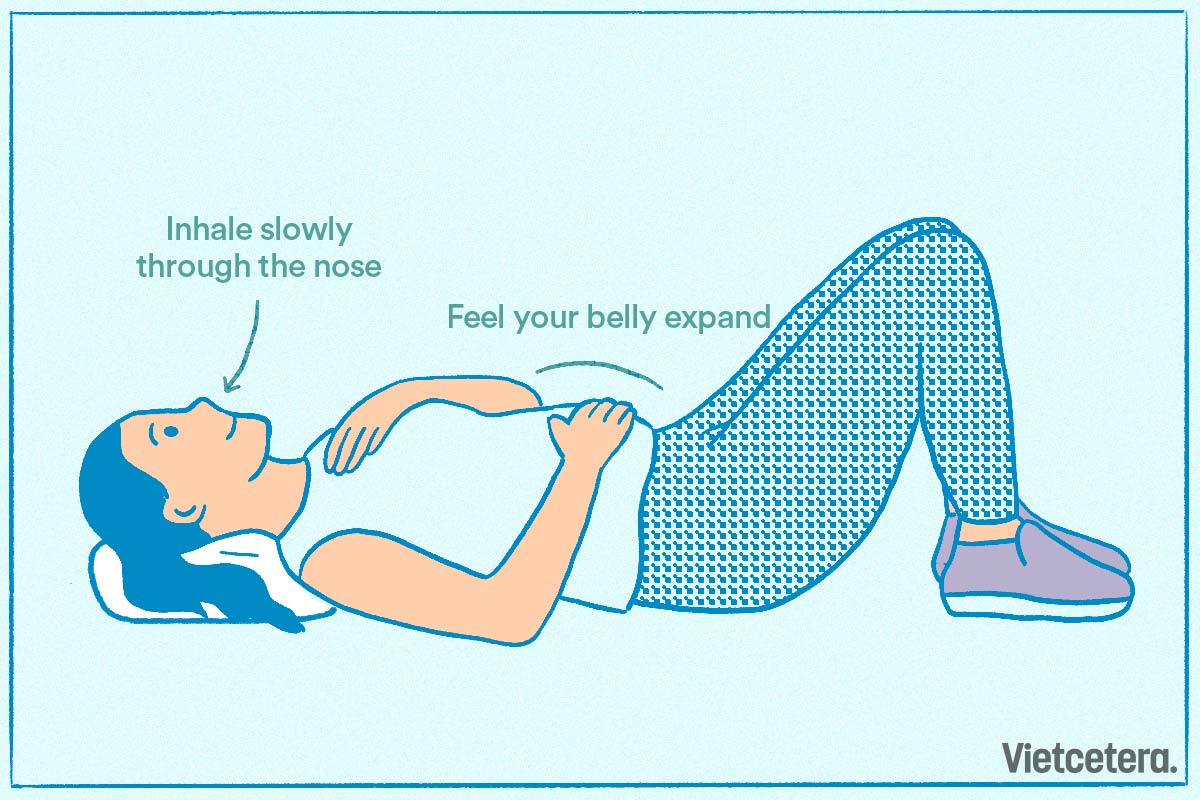Breathing is a natural process that occurs without conscious awareness. In fact, since we were babies, we have known how to breathe through our abdominal muscles (diaphragm).
However, as we grow older, life becomes more hectic and stressful — and this hurried lifestyle unintentionally makes us forget how to properly breathe, from the diaphragm.
In particular, women tend to breathe through their chest more due to fear of affecting their waist sizes. This causes shallower breaths, which then results in rising blood pressure and heart rate.
Diaphragmatic breathing and its benefits

The diaphragm is a large, dome-shaped muscle that separates the rib cage and abdominal cavity (right at the base of the lungs).
When we inhale, the diaphragm contracts and moves downwards, creating space for the lungs to expand and fill with air (O2). On exhalation, the diaphragm relaxes and moves upwards, causing the bottom of the lungs to rise, thereby pushing the gas (CO2) out of the lungs. As a result, the amount of air in and out of the lungs is increased without tiring the respiratory muscles.
Proper diaphragmatic breathing has many benefits:
Prevents respiratory system problems
Improves cardiovascular performance
Stabilizes blood glucose levels
Strengthens the immune system and digestive system
Forms a good posture for the skeleton
Maintains a healthy weight
Improves concentration
Better emotional control
Below are four simple steps to get you used to diaphragmatic breathing.
Step 1: Prepare the pose

Lie on your back, relax your head, neck and shoulders, then relax your whole body and mind.
Bend your knees. You can use a pillow to support your head if that makes you more comfortable.
Place one hand on your chest, and the other on your belly, just below the rib cage.
Step 2: Breathe in slowly through your nose

When inhaling, let the air inward towards the lower abdomen.
Feel your abdomen rise with the hand placed on it.
Your chest doesn't move.
When your abdomen is fully expanded, hold your breath for 3-5 seconds (if you are not used to that amount of time, you can still exhale earlier).
Step 3: Exhale through your nose

When exhaling, slowly pull your belly back towards the wall of your spine.
Gently push the air out from the base of your lungs through the nose, with twice as long as it takes to inhale.
As your abdomen comes back in, it helps the diaphragm relax and create an impact on the base of the lungs.
Step 4: Repeat the cycle

Go back to Step 2 and repeat the process until you’re used to it.
Breathing with your diaphragm can be a bit overwhelming at first, but as you get used to it, it becomes easier and more relaxing.
Note when practicing diaphragm breathing:
Practice 20 minutes per day. You can divide it into twice per day (10 minutes each time), or four times (5 minutes each time).
You should practice diaphragm breathing in an area of natural air (an open window), where it’s quiet and with little interruptions.
During the practice, you just need to focus on keeping the abdomen coming back while exhaling, and expanding to the fullest when inhaling.
The rib cage should remain still throughout the diaphragmatic breathing exercise.
After you are comfortable with the basic lying position, you can start practicing the exercise while sitting or standing. Regardless of your position, it is important to keep your cervical vertebrae and back straight, your chest open, and your head, neck and shoulders relaxed.
Sources: Harvard Health, Medical News Today
With the desire to become a “partner” of Vietnamese people towards Healthier, Longer, Better Lives, AIA Vietnam strives to take care of and improve the community’s health with various activities. The programs “Health Tip”, “Sóng và Máy Tính cho em”, and most recently, “Special Coverage” have all received positive responses from the community. To support employees to stay safe and healthy during the pandemic, AIA Vietnam also launched practical programs, “AIA Care Never Stops” and “Employee Assistance Program (EAP)“, giving employees access to private units of counseling, remote health care guidance, and mental support with psychologists.
With these efforts in 2021, AIA Vietnam is honored to receive the “Vietnam Technology Excellence Awards” at the Asian Technology Excellence Awards 2021; “Great Place To Work” award for the fourth year in a row, and “HR Asia Award 2021”. To find out more about AIA Vietnam and get updated on the current programs, please visit AIA Vietnam’s Linkedin page.
